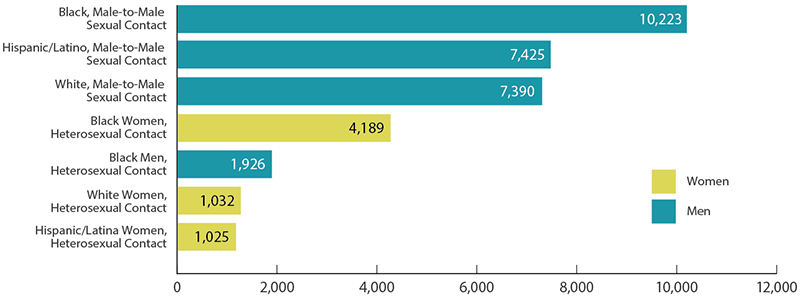HIV Among Women
Though HIV diagnoses among women have declined in recent years, more than 7,000 women received an HIV diagnosis in 2016. Black/African Americana women are disproportionately affected by HIV, compared with women of other races/ethnicities. Of the total number of womenb living with diagnosed HIV at the end of 2015, 59% (137,998) were African American, 19% (43,086) were Hispanic/Latina,c and 17% (38,992) were white.
The Numbers
HIV Diagnosesd
In 2016:
-

Women made up 19% (7,529) of the 39,782 new HIV diagnoses in the United States.
- Heterosexual contact accounted for 87% (6,541) of HIV diagnoses among women.e
- Injection drug use accounted for 12% (939) of HIV diagnoses among all women. But among white women, 28% of HIV diagnoses were attributed to injection drug use.
- Among all women who received an HIV diagnosis, 61% (4,560) were African American, 19% (1,450) were white, 16% (1,168) were Hispanic/Latina, and 5% (351) were other.
From 2011 to 2015:
- HIV diagnoses among all women declined 16%.
- Among African American women, diagnoses declined 20%, among Hispanic/Latina women, diagnoses declined 14%, and among white women, diagnoses remained stable.
HIV Diagnoses in the United States for the Most-Affected Subpopulations, 2016

Source: CDC. Diagnoses of HIV infection in the United States and dependent areas, 2016. HIV Surveillance Report 2017;28.
Subpopulations representing 2% or less of HIV diagnoses are not reflected in this chart.
AIDS Diagnoses
Women accounted for 24% (4,271) of the 18,160 AIDS diagnoses in 2016 and represent 20% (251,653) of the 1,232,346 cumulative AIDS diagnoses in the United States from the beginning of the epidemic through the end of 2016.
Living With HIV and Deaths
- An estimated 255,900 women were living with HIV at the end of 2014, representing 23% of all Americans living with the virus. Of women living with HIV, around 12% (or 1 in 8) do not know they are infected.
- Among all women living with HIV in 2014, 88% had received a diagnosis, 64% received HIV medical care in 2014, 50% were retained in HIV care, and 48% had a suppressed viral load.
- A person living with HIV who takes HIV medicine as prescribed and gets and stays virally suppressed can stay healthy and has effectively no risk of sexually transmitting HIV to HIV-negative partners.
- From 1987 (the first year HIV was listed as a cause of death on death certificates) through 2015, 94,033 women aged 15 and older died from HIV disease. In 2015, 1,667 women died from HIV disease.
Prevention Challenges
- The greater number of people living with HIV (prevalence) in African American and Hispanic/Latino communities and the fact that people tend to have sex with partners of the same race/ethnicity mean that women from these communities face a greater risk of HIV infection with each new sexual encounter.
- Because some women may be unaware of their male partner’s risk factors for HIV (such as injection drug use or having sex with men), they may not use condoms. In a behavioral survey of heterosexual women at increased risk of HIV infection, 92% of HIV-negative women reported having vaginal sex without a condom in the previous year, and 25% reported having anal sex without a condom.
- In general, receptive sex is riskier than insertive sex. This means that women have a higher risk for getting HIV during vaginal or anal sex than their sex partners. The riskiest behavior for getting HIV is receptive anal sex.
- Some sexually transmitted diseases, such as gonorrhea and syphilis, greatly increase the likelihood of getting or transmitting HIV.
- Women who have been sexually abused may be more likely than women who have not to engage in sexual risk behaviors like exchanging sex for drugs, having multiple sex partners, or having sex without a condom.
What CDC Is Doing

CDC is working with state and local partners throughout the United States to maximize the effectiveness of current HIV prevention methods. Some of CDC’s activities include:
- Support for health departments and community-based organizations to deliver effective prevention interventions. A new funding opportunity directs resources to the populations and geographic areas of greatest need, while supporting core HIV surveillance and prevention efforts across the United States.
- Building the capacity of health departments and community-based organizations to effectively implement high impact prevention (HIP) interventions and strategies.
- A 5-year funding opportunity that began in 2014 to provide training and technical assistance for staff of health departments, community-based organizations, and health care organizations to implement HIP programs, including testing and behavioral and biomedical prevention for people who are HIV-positive or at high risk for getting HIV.
- Provide resources to health departments and community-based organizations to deliver these HIP interventions and strategies for women.
- The Act Against AIDS campaigns and partnerships, including
- Doing It, a national HIV testing and prevention campaign that encourages all adults to know their HIV status and protect themselves and their community by making HIV testing a part of their regular health routine;
- Let’s Stop HIV Together, which raises HIV awareness and fights stigma among all Americans and provides many stories about people living with HIV;
- HIV Treatment Works, which shows how people living with HIV have overcome barriers to stay in care and provides resources on how to live well with HIV; and
- Partnering and Communicating Together (PACT) to Act Against AIDS, a 5-year partnership between CDC and leading national organizations representing the populations hardest hit by HIV and AIDS, to intensify HIV prevention efforts in these populations.
a Referred to as African American in this fact sheet.
b Adult and adolescent females aged 13 and older.
c Hispanics/Latinas can be of any race.
dHIV diagnoses refers to the number of people diagnosed with HIV infection, not when the people were infected.
e Heterosexual sex with a person known to have, or be at high risk for, HIV infection.
Additional Resources
Bibliography
- CDC. Diagnoses of HIV infection in the United States and dependent areas, 2016. HIV Surveillance Report 2017;28. Accessed January 16, 2018.
- CDC. Monitoring selected national HIV prevention and care objectives by using HIV surveillance data—United States and 6 dependent areas, 2015. HIV Surveillance Supplemental Report 2017;22(2). Accessed January 16, 2018.
- CDC. HIV infection, risk, prevention, and testing behaviors among heterosexuals at increased risk of HIV infection—national HIV behavioral surveillance, 20 U.S. cities, 2013. HIV Surveillance Special Report 13. Accessed January 16, 2018.
- CDC. Selected national HIV prevention and care outcomes (slides). Accessed January 16, 2018.
- CDC. CDC Wonder: Compressed mortality file, 1979-1998. Accessed February 12, 2018.
- CDC. CDC Wonder: Compressed mortality file, 1999-2016. Accessed February 12, 2018.
- Bauer HM, Gibson P, Hernandez M, Kent C, Klausner J, Bolan G. Intimate partner violence and high-risk sexual behaviors among female patients with sexually transmitted diseases. Sex Transm Dis 2002;29(7):411-6. PubMed abstract.
- Cavanaugh CE, Hansen NB, Sullivan TP. HIV sexual risk behavior among low-income women experiencing intimate partner violence: The role of posttraumatic stress disorder. AIDS Behav 2010;14(2):318-27. PubMed abstract.
- CDC. 2016 sexually transmitted diseases surveillance. Accessed January 16, 2018.
- Crosby RA, DiClemente RJ, Wingood GM, et al. Sexual agency versus relational factors: A study of condom use antecedents among high-risk young African American women. Sex Health 2008;5(1):41-7. PubMed abstract.
- Coker AL. Does physical intimate partner violence affect sexual health? A systematic review. Trauma Violence Abuse 2007;8(2):149-77. PubMed abstract.
- Dinenno EA, Oster AM, Sionean C, Denning P, Lansky A. Piloting a system for behavioral surveillance among heterosexuals at increased risk of HIV in the United States. Open AIDS J 2012;6:169-76. PubMed abstract.
- Herbenick D, Reece M, Schick V, Sanders SA, Dodge B, Fortenberry JD. Sexual behavior in the United States: Results from a national probability sample of men and women ages 14-94. J Sex Med 2010;7 Suppl 5:255-65. PubMed abstract.
- Moreno CL. The relationship between culture, gender, structural factors, abuse, trauma, and HIV/AIDS for Latinas. Qual Health Res 2007;17(3):340-54. PubMed abstract.
- Mosack KE, Randolph ME, Dickson-Gomez J, Abbott M, Smith E, Weeks MR. Sexual risk-taking among high-risk urban women with and without histories of childhood sexual abuse: Mediating effects of contextual factors. J Child Sex Abus 2010;19(1):43-61. PubMed abstract.
- Simoni JM, Sehgal S, Walters KL. Triangle of risk: Urban American Indian women’s sexual trauma, injection drug use, and HIV sexual risk behaviors. AIDS Behav 2004;8(1):33-45. PubMed abstract.
- Tross S, Hanner J, Hu MC, Pavlicova M, Campbell A, Nunes EV. Substance use and high risk sexual behaviors among women in psychosocial outpatient and methadone maintenance treatment programs. Am J Drug Alcohol Abuse 2009;35(5):368-74. PubMed abstract.
Fact Sheets
Other Resources
Web Sites
- AIDS Alliance for Children, Youth, & Families
- Mother to Child Transmission Resources (AIDS Education and Training Centers)
- HIV/AIDS (womenshealth.gov)
- Cervical Cancer and HIV (SmartGlobalHealth.org)
General Resources
- CDC-INFO: 1-800-CDC-INFO (232-4636)
- CDC HIV Website
- CDC Act Against AIDS Campaign
- CDC HIV Risk Reduction Tool (BETA)
- Page last reviewed: July 5, 2018
- Page last updated: July 5, 2018
- Content source: Division of HIV/AIDS Prevention, National Center for HIV/AIDS, Viral Hepatitis, STD, and TB Prevention, Centers for Disease Control and Prevention


 ShareCompartir
ShareCompartir
